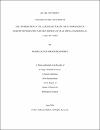The Contribution Of Toll-Like Receptors In The Pathogenesis Of Diabetic Retinopathy In Human Microvascular Retinal Endothelial Cells In Vitro
| Advisor | M Rizk, Nasser |
| Author | Dad Bakhsh, Fadheela |
| Available date | 2017-06-20T07:44:10Z |
| Publication Date | 2016-06 |
| Abstract | Background: Diabetes Mellitus is a chronic systemic inflammatory disease including the eye causing macrovascular as well as microvascular complications known as diabetic retinopathy (DR), thus increasing the risk of vision impairment and blindness among working adults. The activation of the innate immune system during diabetes leads to an increase in certain biomarkers which in turn can antagonize the immune system leading to more complications. Toll like receptors (TLRs) are receptors of the innate immune system, known as pattern recognition receptors, among them TLR4 recently been linked to DR, but scanty data are available. Thus, this research focus on providing insight into the role of TLR4 in the pathogenesis of DR. Human microvascular retinal endothelial cells (HMVRECs) was used to evaluate the contribution of TLR4 in the pathogenesis of DR. Methods: HMVRECs have been treated with high glucose (30 mM) and normal glucose (5.5mM) in addition to antioxidants, and the expression of TLR4, TLR2, NFkB and VEGFA mRNA are measured. The barrier function was assessed by trans electrical resistance impedance using ECIS (Applied Biophysics) in comparison to TLR4 siRNA-transfected cells treated in the same way. TNF-alpha was measured by the Elisa technique. Results: High glucose treatment increases the mRNA expression of TLR4 while the TLR4 siRNA-transfected HG-treated cells attenuates the TLR4 mRNA expression. On the contrary, the inflammation (NFKB expression and TNF-alpha) was not attenuated by silencing TLR4. Additionally, antioxidant treatment did not help the cells to regain normal behavior when TLR4 was silenced. The barrier function disorder observed in normal cells exposed to HG did not improve significantly by silencing TLR4 in these cells. Conclusion: Hyperglycemia induces TLR4 expression, and its downstream signaling induces inflammation, but silencing TLR4 does not restore normal barrier function, indicating that TLR4 alone does not contribute to the pathogenesis of DR. |
| Language | en |
| Subject | Higher education [0745] - primary Health sciences [0566] Biology [0306] barrier function Diabetes Mellitus Diabetic Retinopathy Human Microvascular Retinal Endothelial Cell Culture pathogenesis of DR Toll like receptors |
| Alternative Title | مساهمة المستقبلات الشبيهة بمستقبلات تول في النشوء المرضي لشبكية العين لمرضى السكري في خلايا الانسان للأوعية الدموية الدقيقة داخل الغشاء الباطني لشبكية العين |
| Type | Master Thesis |
| Alternative Abstract | الدراسة الحالية تركز على مستقبلات مناعية معينة تدعى مستقبلات الشبيهة بمستقبلات تول (TLRs)؛ يمكن لهذه المستقبلات تحديد أنماط جزيئية محددة في مسببات الأمراض، وبالتالي القضاء عليها. في هذه الدراسة نقوم بتحديد العلاقة المرضية بين هذه المستقبلات ومرض اعتلال شبكية السكري (DR). هذا المرض من مضاعفات مرض السكري، تؤثر على الأوعية الدموية الصغيرة في شبكية العين ويمكن أن تؤدي إلى العمى. لقد أردنا في هذا البحث التحقق من مساهمة المستقبلات الشبيهة بمستقبلات تول4 (TLR4) في حدوث هذا المرض. قمنا باستخدام خلايا الانسان لبطانة شبكية العين وتمت معالجتها بسكر عالي التركيز حتى تتشابه بيئتها بالخلايا الموجودة في عين مريض السكري. من أجل تقييم دور هذه المستقبلات (TLR4)، تم اثباط المستقبلات الشبيهة بمستقبلات تول4 باستخدام تقنية siRNA الذي يذهب مباشرة داخل الخلية ويقوم بهدم وتكسير المادة النووية المسؤولة عن تكوين هذه المستقبلات بالتالي لا يتم تشكيل هذا المستقبل. وجدنا أن إعطاء الخلية جلوكوز (سكر)عالي التركيز يرفع من مستوى وجود المستقبلات الشبيهة بمستقبلات تول4 (TLR4) ، TLR4في حين أن اثباط siRNAفي هذه الخلايا بالستخدام ومن ثم تعريضها لجلوكوز عالي التركيز لاتزيد من مستوى وجود هذه المستقبلات. وفقا لبيانات منظمة الصحة العالمية التي نشرت عام2014 أن مرض السكري هو المسبب رقم 2 للوفيات في قطر. داء السكري أصبحت أكثر وأكثر شيوعا، ومضاعفاته تتزايد متزامنا معه مثل مرض اعتلال الشبكية السكري . لذلك ينصح ان تقام مثل هذه الأبحاث في قطر تبحث عن استراتيجيات العلاج في بلد يعاني سكانه من هذا المرض. |
| Department | Biomedical Sciences |
Files in this item
This item appears in the following Collection(s)
-
Biomedical Sciences [66 items ]


